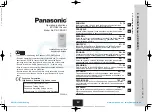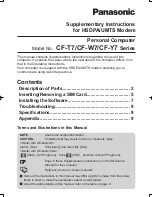
Page 17 of 69
Load-distributing hitches are designed to distribute the hitch weight relatively evenly to all axles
of the tow vehicle and trailer. The tow vehicle and trailer should be in a level position (attitude)
in order for the hitch to do its job properly. Here is how to check:
1)
With the tow vehicle loaded for a trip, measure the distance between the vehicle and the
ground at reference points, which you can establish, in front and rear. Keep the figures handy
for later use.
2)
Hitch the trailer and adjust the tension on the spring bars so the tow vehicle remains at
roughly the same attitude (i.e., if the rear drops an inch after hitching, the front should also
drop an inch).
3)
Inspect the trailer to be sure it is level. If not, hitch ball height should be raised or lowered, as
necessary. You may need spring bars rated for more weight if you cannot keep the tow
vehicle from sagging in the rear.
Safety Chains
Safety chains are required for travel trailers. The purpose of safety chains is to prevent the trailer
from separating from the tow vehicle in event of hitch failure such as a hitch ball that has
loosened. The chains should be crossed in an "X" fashion below the ball mount, with enough
slack that they do not restrict turning or allow the coupler to hit the ground.
Suggestion: We put
a plastic hose wrap, available at hardware stores, over the chains, so they don’t mess up the front
of our Bigfoot when we separate and put the chains over the tongue (see Page 20).
Brakes
As with any vehicle, the proper operation of the tow vehicle’s braking system is essential for
vehicle control. Brakes are required on any trailer coach or camp trailer having a gross weight of
1500 lbs. or more. Typical braking distances increase dramatically with the addition of a trailer
and its contents in tow. Periodic inspection and maintenance of the vehicles braking system shall
follow the automobile manufacturer’s recommendations at a minimum. Reference the
manufacturer’s recommendations for brake selection.
Trailers are equipped with separate brakes that should be considered a continuation of the tow
vehicle’s brake system. The trailer brakes are integrated into the tow vehicle brakes and activate
in combination with the tow vehicle brakes. Most conventional and fifth-wheel trailers have
electric brakes, activated by a controller in the tow vehicle. The controller automatically
coordinates the tow vehicle and trailer braking so the two systems work together when the brake
pedal is applied.
The controller can also be helpful in stabilizing a trailer that sways because of bad road
conditions. Manually applying the trailer brakes by using the hand lever on the controller will re-
stabilize a trailer that is likely to sway.
Electronically Controlled Brakes
The electric brakes on your trailer are similar to the drum brakes on your car or truck. The basic
difference between them is that your trailer brakes are operated by 12-volt direct current from the
tow vehicle, rather than by direct hydraulic action.
Summary of Contents for T2801
Page 2: ...BIGFOOT TRAILER MANUAL DRAFT 8 APRIL 3 2008 ...
Page 36: ...Page 34 of 69 ...
















































